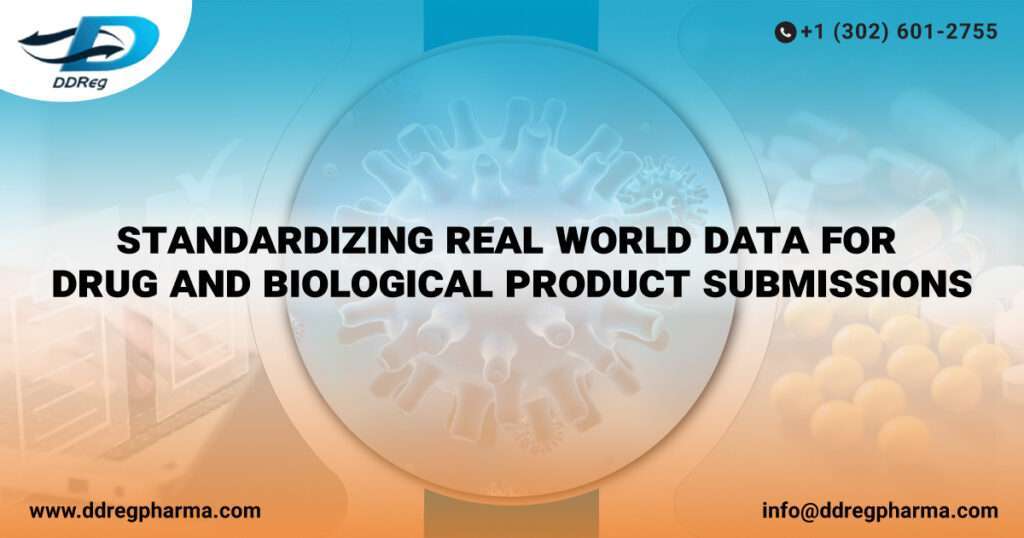Real world data (RWD) is proving to be an important source of information for applications such as New Drug Applications (NDAs), Abbreviated New Drug Applications (ANDAs), biologic license applications (BLAs) and Investigational New Drug (IND) applications. With RWD being submitted as relevant “study data”, certain agencies like the US FDA, require that the format should be electronic. This is so that agencies can process, review, and archive (unless the submission is waived or exempt from electronic submission). For example, the US FDA can process/review/archive clinical & non clinical study data electronic submissions, including those from RWD sources, that use the standards outlined in the Data Standards Catalog (Catalog). In support of those and in a significant stride towards integrating real-world evidence (RWE) into regulatory decision-making, the US FDA the Data Standards for Drug and Biological Product Submissions Containing Real-World Data guidelines to provide clear recommendations for sponsors for compliance in using standards mentioned in Catalog for submission of RWD source data in applicable drug submissions.
Challenges in Real-World Data Standardization
The FDA acknowledges the difficulties in standardising research data derived from RWD sources for drug submissions. Challenges include diverse and inconsistent formats of RWD sources (e.g., Electronic Health Records, registries), potential use of multiple RWD source types in a study, variations in regional and global data standards, exchange formats and terminologies. Other challenges involve information existing only in non-structured documentation, diverse methods for creating datasets, and factors affecting data quality such as business processes, inconsistent vocabularies, database structure, coding systems, and de-identification methodologies. Access levels to data sources also vary. Addressing these challenges depends on specific data and research, prompting sponsors to engage with FDA review divisions early in the study process for guidance.
Documentation and Processes
Establishing adequate processes during data curation and transformation is essential for ensuring confidence in the resultant data. Documentation of these processes should include electronic records, such as audit trails and quality control procedures. It is important to document any additions, deletions, or alterations made to the data from the source data system to the final study analytic data set(s). Sponsors are advised to document changes to data to align with current FDA-supported data standards. The documentation should also outline the potential impacts of these changes on the study data. Reference is made to the Study Data Technical Conformance Guide (TCG) as a valuable resource providing recommendations, specifications, and general considerations for submitting standardised study data and documentation. The TCG supplements the Study Data Guidance and standards listed in the Catalog, offering guidance on how to submit data using FDA-supported data standards.
Considerations for Conforming Real-World Data
In the process of transforming RWD into formats consistent with FDA-supported data standards, sponsors may face various challenges. These challenges include managing semantic concepts, such as medication information, that appear in multiple locations within health records. Inconsistent or incorrect coding of concepts, changes in data collection or coding practices (e.g., ICD-9 to ICD-10 code transitions), and missing information are also common issues.
Sponsors are advised to document these data challenges encountered during the transformation to FDA-supported data standards. Furthermore, they should provide a justification for the approach taken to ensure compliance with these standards. The mapping of standards and terminologies can be detailed using Define-XML and domain data files. For more intricate discussions, narrative descriptions should be included in the Study Data Reviewer’s Guide, either within the main body or as an appendix. Reviewers can refer to Define-XML and dataset/domains for more in-depth information, if necessary. This comprehensive documentation facilitates the application and review of FDA-supported data standards.
Conclusion
The release of the final guidance on real-world data standards marks an important moment in the integration of RWE into regulatory decision-making. Sponsors are encouraged to carefully adhere to the outlined recommendations, engage in early discussions with the FDA, and leverage available resources for successful incorporation of RWD into drug submissions. While the guidance reflects the current thinking of the FDA, it remains non-binding, allowing for flexibility in approach as long as statutory and regulatory requirements are met.
Reach out to DDReg for expert and end-to-end regulatory services to support first-time-right drug and biological product submissions. Missed the previous blog? Read it here: Streamlining Clinical Investigations for Medical Devices.

